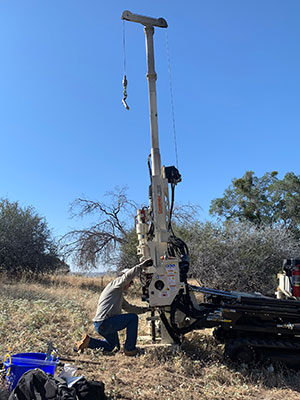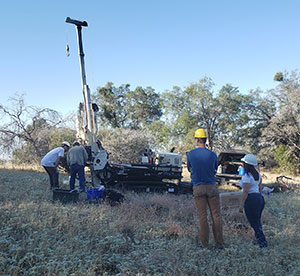UW Professor Leads Study That Finds Physical Weathering of Rock Breakdown More Important Than Previously Recognized
Published January 13, 2021

Research led by the University of Wyoming shows that physical weathering is far more important than previously recognized in the breakdown of rock in mountain landscapes. Because it is difficult to measure, physical weathering has commonly been assumed to be negligible in previous studies.
Cliff Riebe, a professor in UW’s Department of Geology and Geophysics, headed a research group that discovered that climate and erosion rates strongly regulate the relative importance of subsurface physical and chemical weathering of saprolite, the zone of weathered rock that retains the relative positions of mineral grains of the parent bedrock and lies between the layer of soil and harder rock underneath. Saprolite is much like the weathered granite found on the flat areas surrounding the hard granite of Vedauwoo.
“Our work shows that physical strain can no longer be ignored in studies of subsurface weathering. It’s not just a chemical process. It is physical as well,” Riebe says. “What we found is that anisovolumetric weathering is much more common than previously thought, and that variations in this process can be explained by climate and erosion.”
Riebe is lead author of a paper, titled “Anisovolumetric Weathering in Granitic Saprolite Controlled by Climate and Erosion Rates,” which was published in the Jan. 12 issue of Geology. The journal publishes timely, innovative and provocative articles relevant to its international audience, representing research from all fields of the geosciences.
Others from UW involved in the research are Russell Callahan, a UW Ph.D. student from Floyd, Va.; Sarah Granke, from Sunnyvale, Calif., who graduated with a master’s degree in geology this past summer; Bradley Carr, a UW associate research scientist in geology and geophysics; and Marlie Schell, of Hoback Junction, who received her master’s degree in 2019. All are co-authors of the paper.
Other contributors to the paper were Jorden Hayes, a 2016 UW Ph.D. graduate and now an assistant professor of earth sciences at Dickinson College in Carlisle, Pa.; and Leonard Sklar, a professor in the Department of Geography, Planning and Environment at Concordia University in Montreal, Canada.
The study looked at three sites -- with differing climates and elevations of granitic bedrock -- of the Sierra Nevada, a mountain range in California.
In the lingo of geochemists, weathering has long been assumed to be “isovolumetric,” meaning without a change in volume caused by physical strain.

“Our work shows that, to the contrary, weathering is commonly ‘anisovolumetric,’ meaning that strain caused by physical weathering is important,” Riebe says.
Riebe credits some of the tools and instruments that were purchased from the Wyoming Center for Environmental Hydrology and Geophysics (WyCEHG) EPSCoR (Established Program to Stimulate Competitive Research) project that ended a few years ago as the reason his team could measure both physical and chemical weathering at several sites in California.
“The reason why weathering was difficult to measure in the past is you have to be able to access the deep subsurface and sample it without disturbing it,” Riebe explains. “You need a Geoprobe push coring system, which is basically a big track-mounted drill rig, to do this.
“It’s expensive work, especially if you do not happen to own a Geoprobe and have to hire someone to do the work,” he continues. “Fortunately, we have access to this equipment and the expertise to operate it through Wyoming’s Near Surface Geophysics facility, which is ably managed by Brad Carr, one of the study’s co-authors.”
The research was funded by grants from the National Science Foundation (NSF), NASA and the Natural Sciences and Engineering Research Council of Canada.
Riebe says there is a direct correlation between the research in this paper and the $5.33 million NSF grant he received last September. The grant focuses on connections among rock, water and life at Earth’s surface.
“This research is partly supported by that grant and also helped inspire it,” Riebe says.

